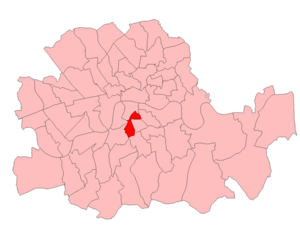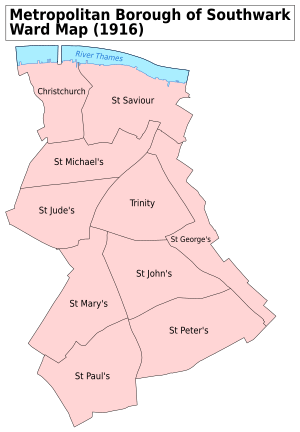Southwark Central (UK Parliament constituency) facts for kids
Quick facts for kids {{{Name}}}[[{{{Type}}} constituency]] |
|
|---|---|
| [[Image:{{{Map1}}}Constituency.svg|120px|]] [[Image:England{{{Map2}}}.svg|120px|]] |
|
| {{{Name}}} shown within [[{{{Entity}}}]], and {{{Entity}}} shown within England | |
| Created: | {{{Year}}} |
| MP: | {{{MP}}} |
| Party: | {{{Party}}} |
| Type: | House of Commons |
| County: | [[{{{County}}}]] |
| EP constituency: | [[{{{EP}}} (European Parliament constituency)|{{{EP}}}]] |
Southwark Central was a special area in South London that elected one person to represent it in the UK Parliament. This elected person is called a Member of Parliament, or MP for short. They work in the House of Commons to make decisions for the country.
Southwark Central was a small, busy area in the city. It was one of three parts of the bigger Southwark area. This special area was created in 1918, just after a group called the Boundary Commission suggested it. It was first used in the general election that year.
Later, in 1946, the Southwark area had about 67,279 voters. Because of this number, the whole Southwark area was only allowed to have one MP. So, Southwark Central, along with its neighbours Southwark North and Southwark South East, was closed down as a separate area in 1950. It became part of a new, larger area simply called Southwark.
Where Was Southwark Central?
When Southwark Central was first created, it included three main parts of the Metropolitan Borough of Southwark. These parts were called St Mary's, St Paul's, and Trinity wards. It also included a small piece of the St George's ward.
The area had two main sections connected by a very narrow strip of land. This strip was around a famous place called Elephant and Castle. The southern part of the area was mostly homes. It stretched towards Kennington Park and Avenue Road. Around Elephant and Castle, the area included Newington Butts and the Metropolitan Tabernacle. At its narrowest, it was only about 100 yards wide.
North of Elephant and Castle, the area turned east. It included another part of Newington between New Kent Road and Newington Causeway. The southern edge of this part went along New Kent Road. It also went up to Tower Bridge Road, which was the border with Bermondsey. One of its MPs, Roy Jenkins, once called it "postage stamp-sized" because it was so small.
People Who Represented Southwark Central
The people listed below were the Members of Parliament (MPs) for Southwark Central. They were elected to speak for the people of Southwark Central in the UK Parliament.
| Election | Member | Party | |
|---|---|---|---|
| 1918 | James Daniel Gilbert | Coalition Liberal | |
| 1922 | National Liberal | ||
| 1923 | Liberal | ||
| 1924 | Harry Day | Labour | |
| 1931 | Ian Horobin | National | |
| 1935 | Harry Day | Labour | |
| 1940 by-election | John Hanbury Martin | Labour | |
| 1948 by-election | Roy Jenkins | Labour | |
| 1950 | constituency abolished: see Southwark | ||
Images for kids




